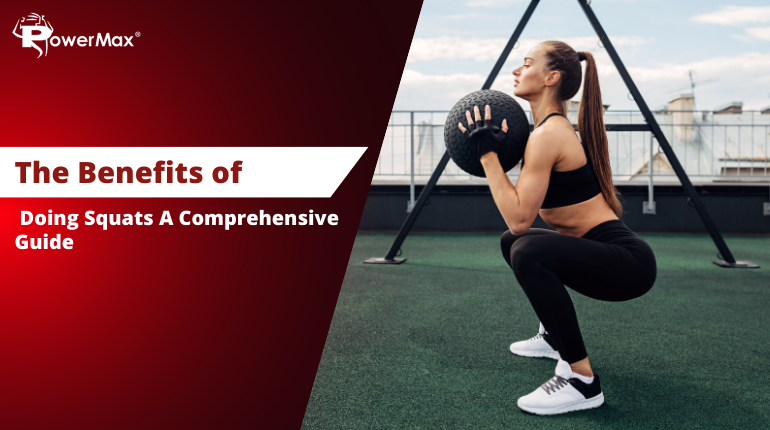Often regarded as the "king" of all exercises, squats are pillar of any well-rounded fitness program. Beyond only increasing strength, they work several muscle groups, encourage flexibility, and provide a multitude of other advantages. Whether you visit a gym regularly or just starting, adding squats to your program will help you noticeably increase your general well-being and physical condition. This blog will go over the benefits of doing squats and the reasons they should be a mainstay of your workout plan.
What Are Squats?
Understanding what squats are and how they function can help one appreciate the advantages. Considered a complex exercise, squats work several muscular groups at once. Fundamentally, a squat is bending the knees and lowering the body towards the ground as though you were seated back into a chair, then rising back up to a standing posture.
although you add resistance like dumbbells or a barbell, squats activate the core, back, and even the arms even although they mostly train the muscles in your lower body—that is, the quadriceps, hamstrings, glues, and calves.
1. Building Lower Body Strength
Squats clearly help to strengthen lower body muscles, which is one of its main advantages. Correctly performed squats work the main muscles in your hips and legs, including:
-
Front of the thighs: quadriceps
-
Back of the thighs, or hamstrings,
-
Gluteus Maximus, sometimes known as glues
-
Calves
-
Hip Flexion
Your muscles cooperate to regulate the movement, increase stability, and build muscular endurance when you do squats. For daily activities including walking, running, climbing stairs, or lifting heavy objects, your entire lower body strength—which is crucial—increases by regular squat inclusion into your exercise program.
Squats also boost lower body muscle mass, which might improve muscle definition and tone. Furthermore supporting better posture and enhanced performance in other exercises and activities is a stronger lower body.
2. Enhancing Core Strength and Stability
Though they are well-known for increasing leg strength, squats also work the core. Maintaining good posture and stability during the squat requires the core muscles—which comprise the abdominals, obliques, and lower back.
Your core has to activate when you drop yourself into a squat to keep your torso straight and stop it from rounding. Over time, this involvement builds your core muscles, thereby enhancing your balance and posture. Not only does a strong core improve sports performance, but it also helps to lower the chance of injury during other activities or daily chores requiring bending or lifting.
3. Increasing Flexibility and Range of Motion
Especially in the hips, knees, and ankles, squats increase range of motion and flexibility. Particularly in deeper ranges, squat helps your body to go through a complete range of motion, therefore improving flexibility over time.
For several reasons, this more flexibility is advantageous. It lowers risk of injury, enhances functional movement patterns, and helps mobility. Deeper squats, for instance, can help you complete other workouts including deadlifts or lunges and might even make leaning down to tie your shoes more comfortable.
Furthermore, enhanced ankle mobility from squats helps to improve balance as you age and lowers fall risk. By inducing synovial fluid—which lubricates your joints and promotes their smooth movement squats help with joint health.
4. Burning Calories and Promoting Fat Loss
One great approach to burn calories and help with fat loss are squats. Squats need more energy than isolation workouts (like bicep curls or tricep extensions) as a complex exercise involving many big muscle groups at once. This greater energy consumption results in more calorie burn both during and following your exercise.
Squats also help build muscle; the more muscular mass you have, the more calories your body uses at rest. This is sometimes referred to as the "afterburn effect," or excess post-exercise oxygen consumption (EPOC), which increases metabolic rate long beyond the end of exercise.
Whether your body composition goals are weight loss or muscle gain, squats can help you meet them when accompanied with a good diet and well-rounded exercise program.
5. Improving Functional Strength
The capacity of squats to increase functional strength is among their main advantages. Functional strength is the capacity to safely and quickly do daily duties. Squats replicate the actions we do many times per day—that of sitting, standing, and bending—natural movement patterns.
Squats can help ordinary tasks like lifting groceries, carrying heavy objects, or standing up from a seated position easier and safer by building the muscles engaged in these motions. Older persons especially need this kind of functional strength since it keeps their freedom and reduces fall and injury risk.
6. Boosting Athletic Performance
Almost every sport's athlete gains from integrating squats into their training schedules. Squats increase power, speed, agility, and endurance regardless of your sport—run, football, bike, or tennis. This is how:
In sports requiring jumping, running, or rapid movements, strength in the hips and legs—which squats build—is crucial for producing power. Faster and more explosively movement is made possible by a fully developed lower body.
Squats help to increase muscular endurance, which is necessary to keep up physical activity for extended times. Squats help you run a marathon or play basketball by increasing your capacity to operate without rapidly tired.
Lower body strength and coordination acquired from squats help you to maintain balance and quickly change direction, two fundamental components of sports agility.
7. Enhancing Bone Health
A weight-bearing exercise, squats help to increase good bone density. Natural declining bone mass as we age can cause disorders including osteoporosis. Still, weight-bearing activities like squats boost bone development and can help stop bone loss.
Squats help to produce osteoblasts, which are cells in charge of creating fresh bone formation, by stressing the bones in your lower body. Particularly in older folks, this increases your bone strength and lowers your chance of fractures.
8. Supporting Joint Health
Unlike the belief that squats could strain your hips or knees, done correctly they can actually aid to promote joint health. For those joints—the knee, hip, and ankle—squats increase the strength and suppleness of the muscles surrounding them, thereby offering better support.
Squats also help to lubricate the joints by increasing synovial fluid flow, therefore lowering friction. This can assist to maintain the health of the joints and lower the risk of disorders such arthritis.
9. Improving Posture
Strong glues, quads, hamstrings, and a strong core all help posture. Regular squatting helps your body to remain an upright, balanced posture. This increases the muscles in your core and back, so facilitating optimal posture all through the day.
Prevention of back pain, neck strain, and other musculoskeletal problems depends on good posture. Squats assist you have better alignment in your spine, thereby relieving some load on your muscles and ligaments.
10. Convenient and Versatile
Convenience of squats is another main advantage. You may perform them without costly equipment or a gym membership. Those with hectic schedules or those who would rather work out at home will find squats to be a perfect exercise since they can be done anywhere, anytime.
Different squat forms also let you push yourself as you advance. Each of bodyweight squats, goblet squats, sumo squats, Bulgarian split squats, and barbell squats targets different muscles in somewhat different ways. This adaptability guarantees ongoing development and keeps your leg workouts interesting.
Conclusion
Among the most powerful exercises you can incorporate into your program, squats have a variety of advantages that go much beyond only increasing leg strength. From increasing flexibility and joint health to boosting weight loss and sports performance, squats are a fundamental action for everyone trying to create a strong, functional body.
Squats should be a mainstay of your program regardless of your level of experience with exercise or athletics. They will not only help you build strength, power, and endurance but also offer functional advantages that show up in better daily mobility, better posture, and less chance of injury.
You should so start including squats into your exercises if you are not now performing them. Consistent and correct form will help you quickly reap the several physical and health advantages of this easy but quite powerful workout.
 India (INR)
India (INR)
 UAE (AED)
UAE (AED)
 Store Locator
Store Locator



-thumb.jpg)
-thumb.jpg)
-thumb.jpg)
-thumb.jpg)
-thumb.jpg)
-thumb.jpg)
-thumb.jpg)

-thumb.jpg)
-thumb.jpg)